Seminar Report
copyright © 2018 Douglas Tong, all rights reserved
__________________________________________________
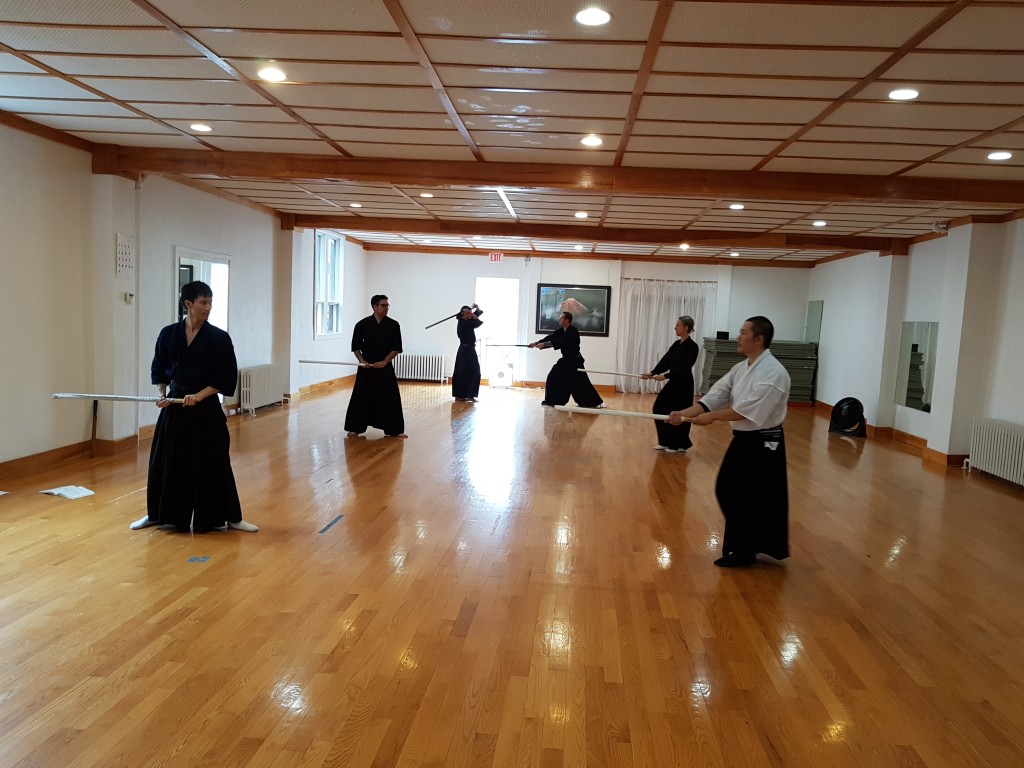
Sensei Tong’s second seminar in Ottawa featuring Yagyu Shinkage Ryu was another landmark event. Over a two-day period, the seminar participants got a good look at the fundamental ideas and techniques of Yagyu Shinkage Ryu. Here are two seminar reports written by Tong Sensei’s assistant instructors who were present at this seminar.
__________________________________________________
The Three Learnings – A Seminar Reflection
copyright © 2018 Erika Gaal, all rights reserved.
__________________________________________________
Even in the midst of the stifling, frenzied heat of summer you can find a cool, collected and calm environment in which to grow.
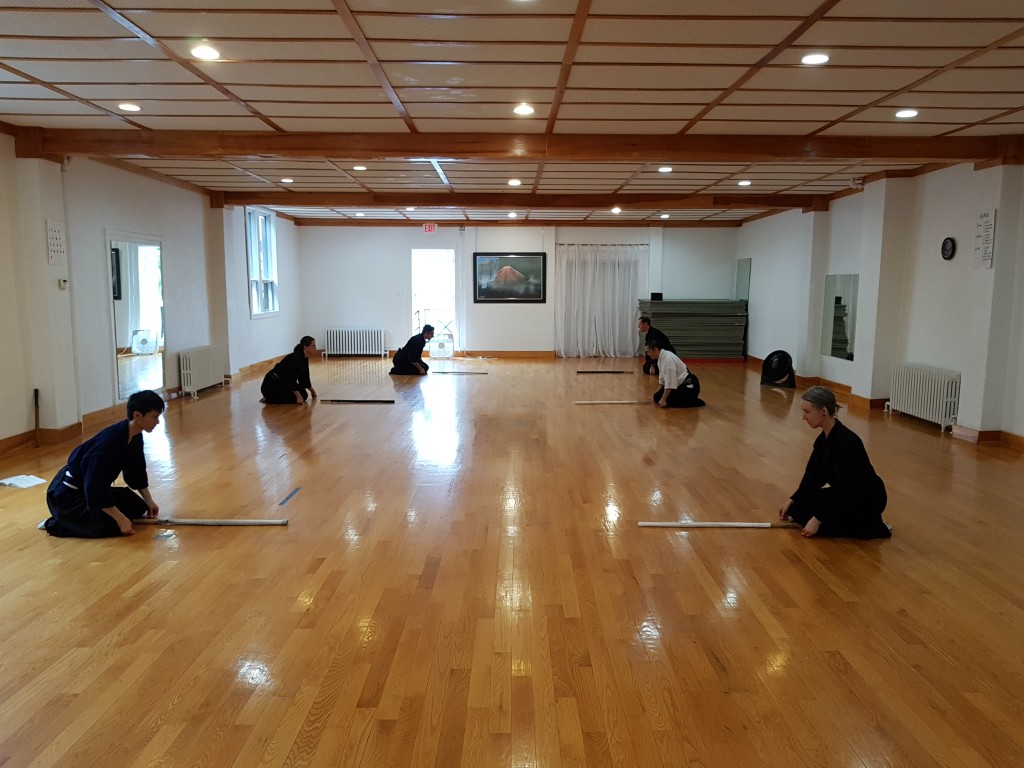 The students practiced the tradition of the Yagyu style of swordsmanship, customs that go back 450 years.
The students practiced the tradition of the Yagyu style of swordsmanship, customs that go back 450 years.
Over the humid Labour Day weekend, I had the honour of hosting our second Ottawa seminar in Yagyu Shinkage Ryu with the ever wonderful Tong Sensei. And although the weather conditions were less than favourable, we had an immensely joyful and enlightening training experience.
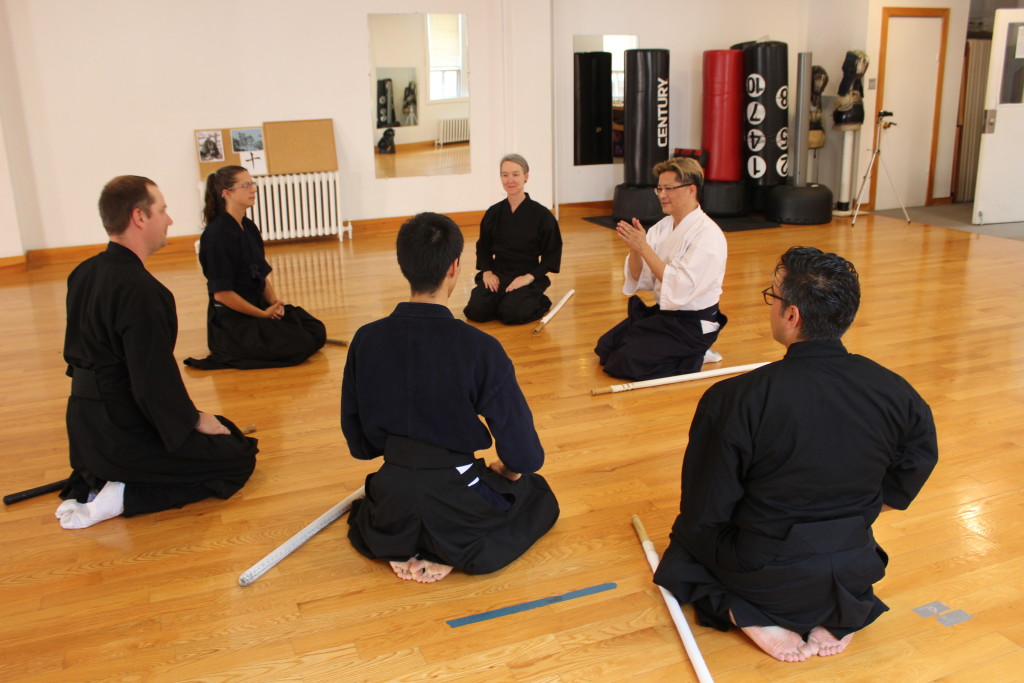 Douglas Tong Sensei talking to the students about the history and tradition of the Yagyu school
Douglas Tong Sensei talking to the students about the history and tradition of the Yagyu school
Our first day started with Kurai and partner exercises. Although these things seem simple enough in theory, they are the foundations on which everything is built and full of complexity. Sure enough, we had much to work on and spent a lot of much needed time working on the details.
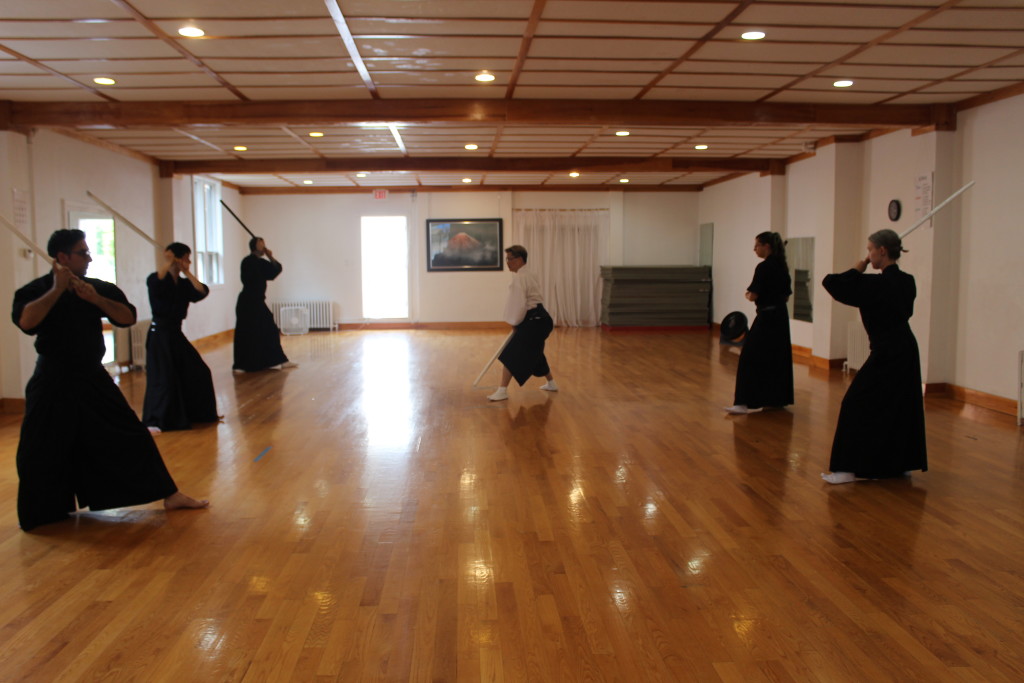 Working on the fine details of select kurai (stances and positions).
Working on the fine details of select kurai (stances and positions).
When Sensei thought our basics were sufficient, we moved on to start the curriculum for the weekend: Sangakuen-no-Tachi. This set of five kata are the entry level and most basic set, and in which the seminar was named. There are three levels of learning to these, each level progressing and building from the last. We spent Saturday covering the Ue Kara level – or the first level – and quickly realized there is nothing basic about it. This level focuses on the three elements that build the foundation of swordsmanship – our posture, movement of arms and legs, and of course our sword.
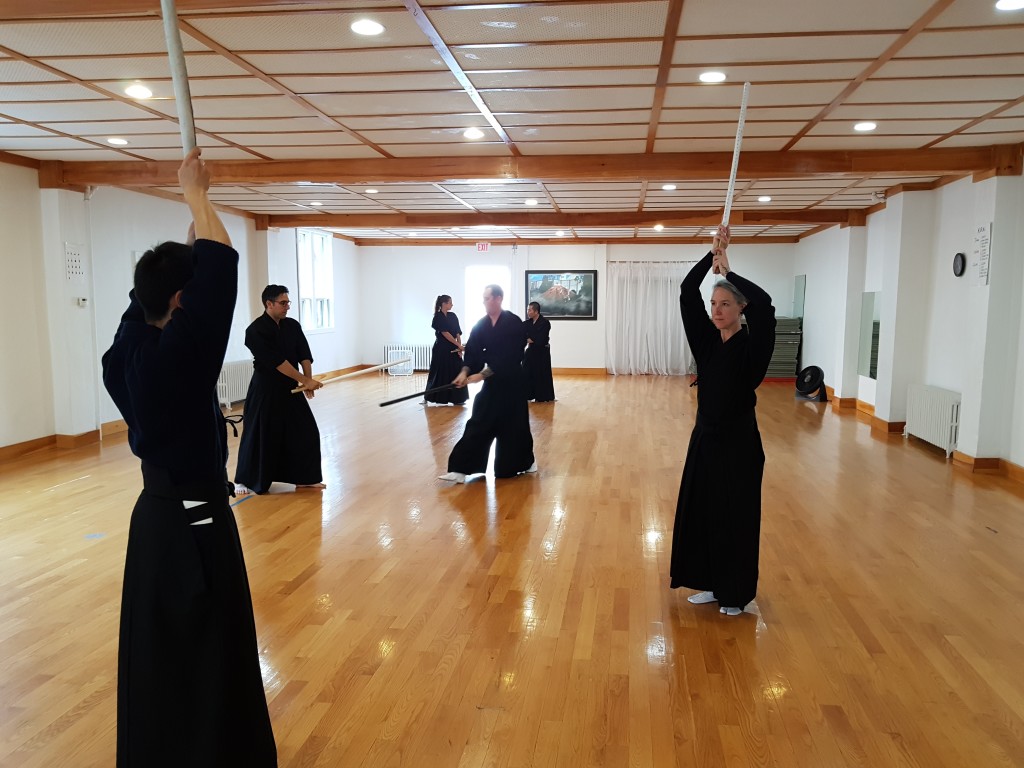 The students working through the katas, focusing on clean form.
The students working through the katas, focusing on clean form.
As the day progressed, we had demonstrations of the kata by Tong Sensei and Sensei Lo, and we saw clearly how important proper execution of technique is. Not only proper technique through motion, but also in mentality as I observed the connection between holding rigidity in our body and the rigidity in our minds. As students of the sword, we all struggle with maintaining calmness while facing an opponent, and it is clearly displayed by our movements. When we calm the mind, our physique changes and we move in a much more relaxed and flexible manner.
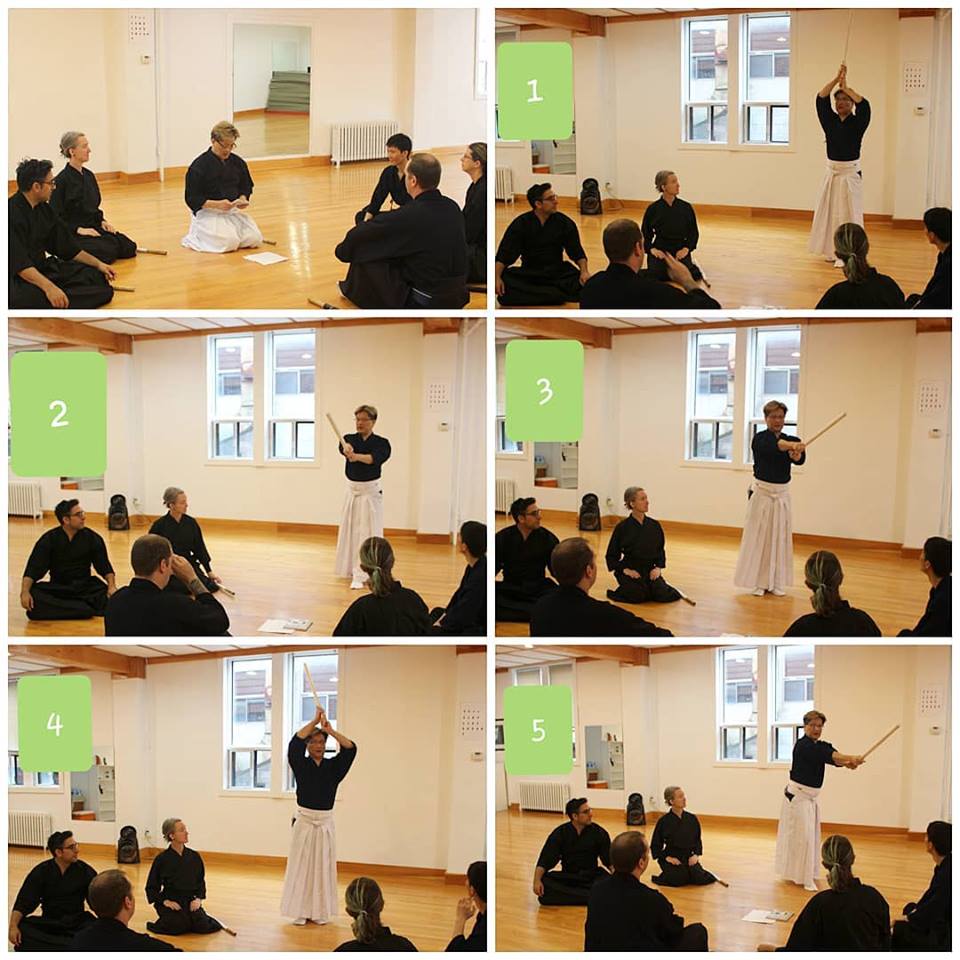 Tong Sensei demonstrating the proper execution of technique.
Tong Sensei demonstrating the proper execution of technique.
Throughout the day, we had breaks where we were briefly introduced to using two swords – one full length (Odachi) and one short (Kodachi). This adds a completely different element and challenge to your understanding of the sword. For one, using your left hand to cut on its own proved to be very unfamiliar to most of us, as was the size of the tool we were cutting with. Body mechanics, coordination, and distance played a key role as we familiarized ourselves with doing different things with each of our occupied hands.
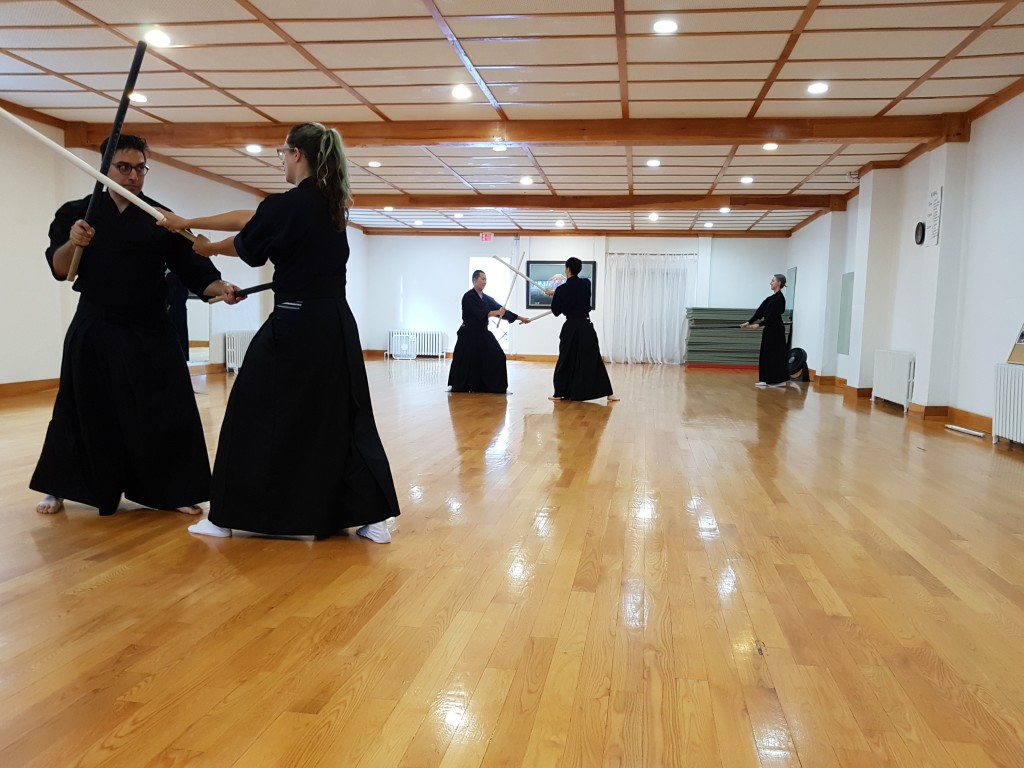 The students got the chance to experience two-sword techniques, which are actually quite challenging.
The students got the chance to experience two-sword techniques, which are actually quite challenging.
There was also the challenge of overcoming fear, as you have to be comfortable with stepping into what we refer to as the ‘danger zone’. This is the area where you are within striking distance of your opponent. The part of this that challenges our fear is that we are in a waiting stance as we enter that zone and bait the opponent to attack. This leaves us completely open to being harmed. Timing is crucial as you must get in and out of that zone at exactly the right moment.
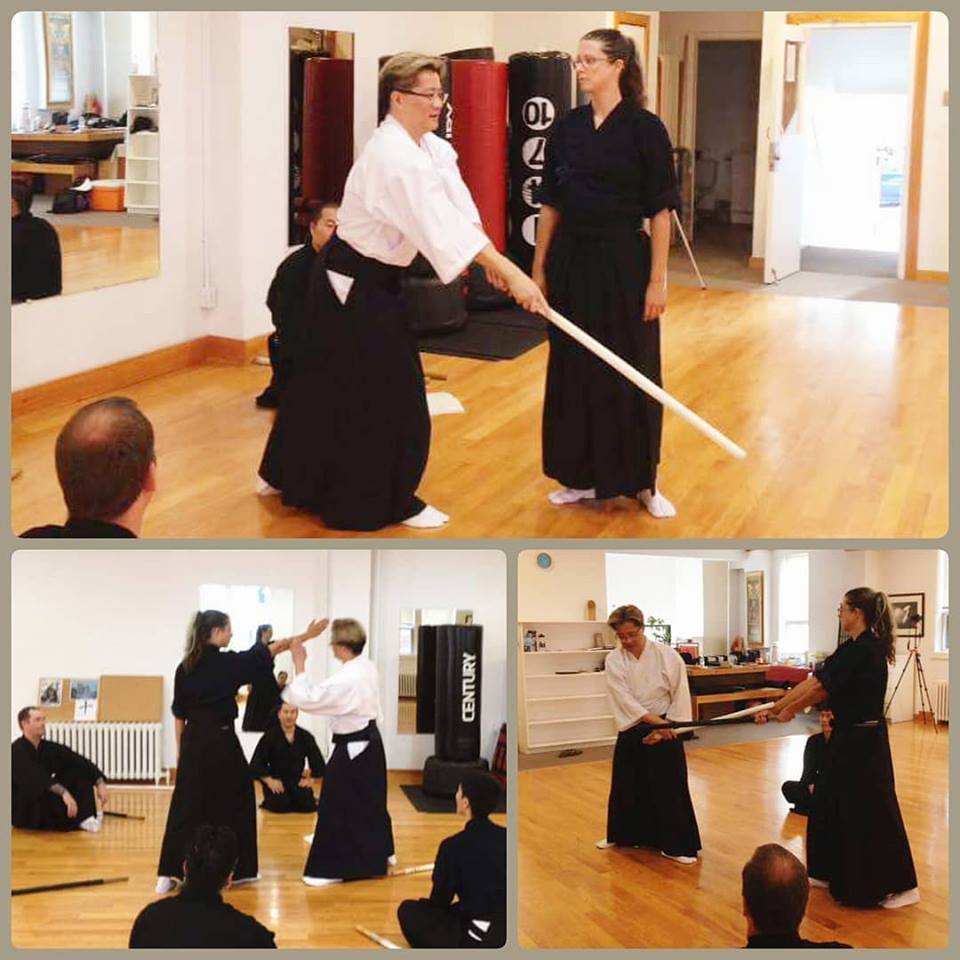 Stepping into an attack is not a natural action. You must have courage. You must conquer your innate fear, which is a completely natural human reaction to someone attacking you.
Stepping into an attack is not a natural action. You must have courage. You must conquer your innate fear, which is a completely natural human reaction to someone attacking you.
At the end of our first day, we went across the street to a wonderful (but very hot!) wood oven pizza restaurant where we were able to reflect on what we learned and have a chance to socialize before heading home to rest for the next day. The energy was relaxed and comfortable between us, and we all enjoyed our food and each other’s company.
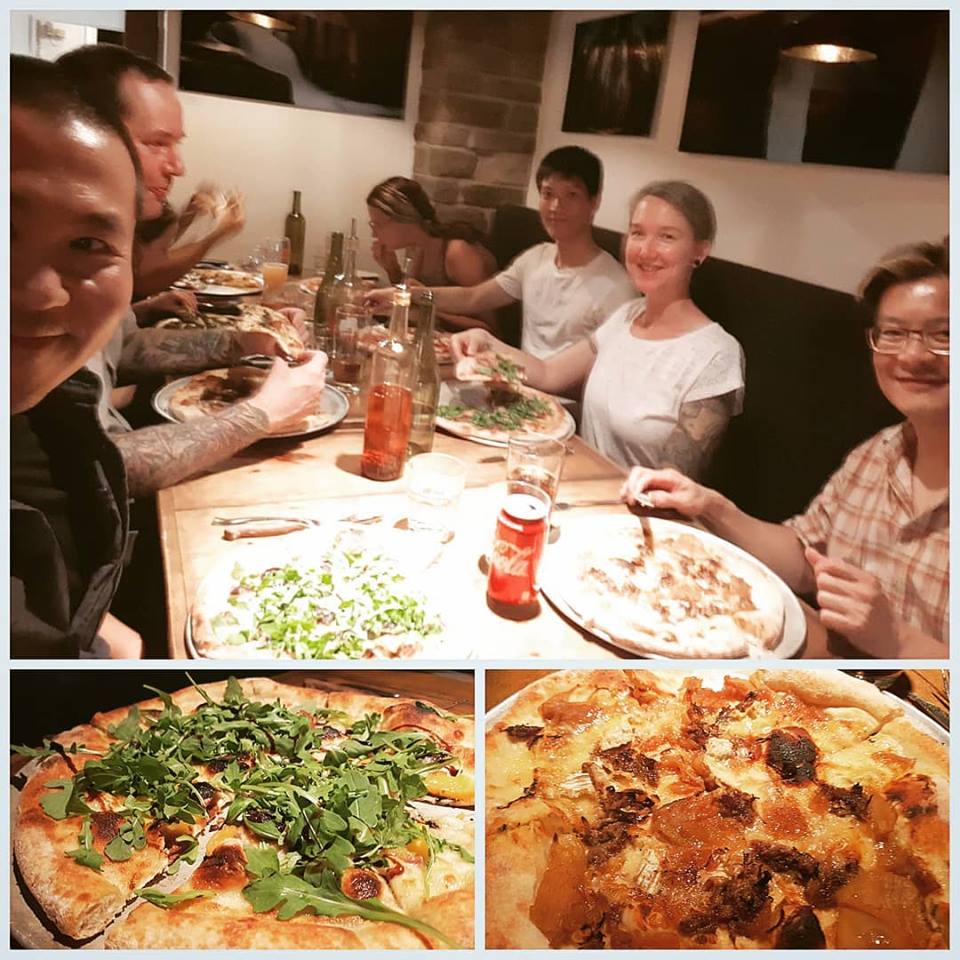 The group enjoying a nice dinner together at Tennessy Willems, a popular pizza parlor across the street.
The group enjoying a nice dinner together at Tennessy Willems, a popular pizza parlor across the street.
The next day turned out to be more hot and humid than the last, but we all arrived with an even more enthusiastic and motivated spirit despite it. After working so hard on the specifics of the first level, we were excited to spend the day on the next level of the same set of kata. As I mentioned before, there are three different levels of training in this set and the Shita Kara level puts its focus on fluidity. By the time you get to practicing this set, you have already solidified the steps and techniques from the first level, so here we can release our concentration on performing those correctly and aim to have the calm mind that this school is known for. Only once you have calmed the mind can you move with accuracy and fluidity in harmony.
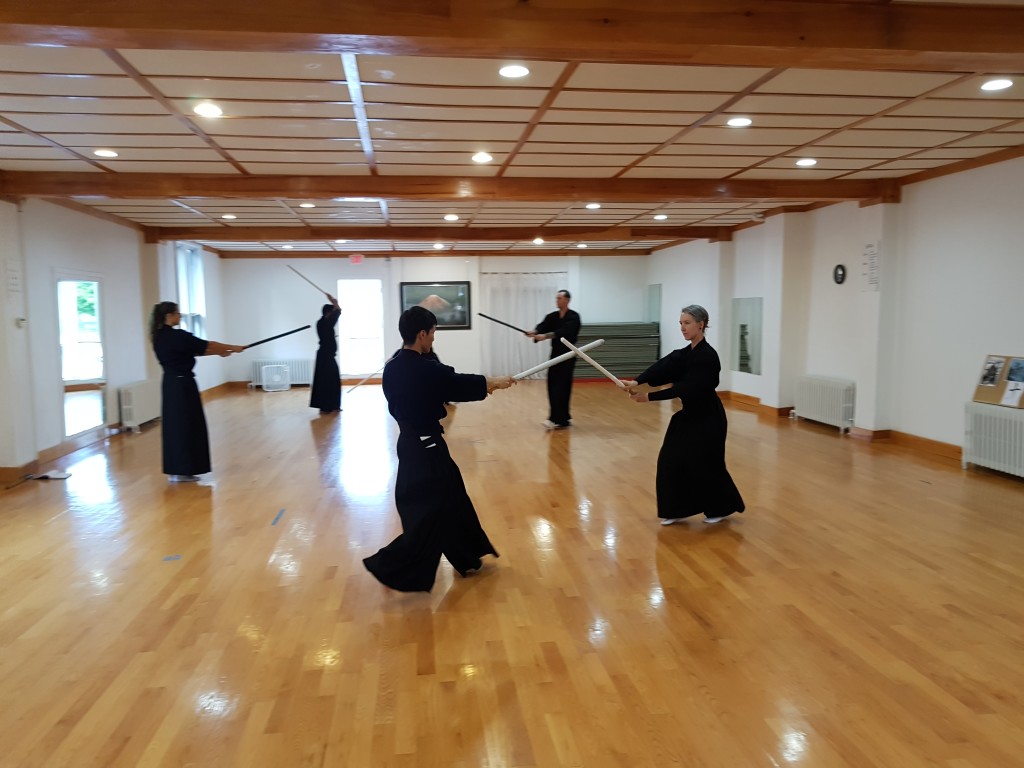 Maintaining a calm mindset in the midst of moving quickly and fluidly was a key point today.
Maintaining a calm mindset in the midst of moving quickly and fluidly was a key point today.
It was while practicing and watching everyone else practice these kata that I really saw just how much that calm state affected everything. Things like posture – our shoulders, whether we’re leaning forward, and our stance – are greatly affected by our mindset. Even our balance at any time can show whether we are holding tension, if we’re too static in our ability to move, or are thinking too ahead – all reflections of how calm we are. It was an eye-opening day for me.
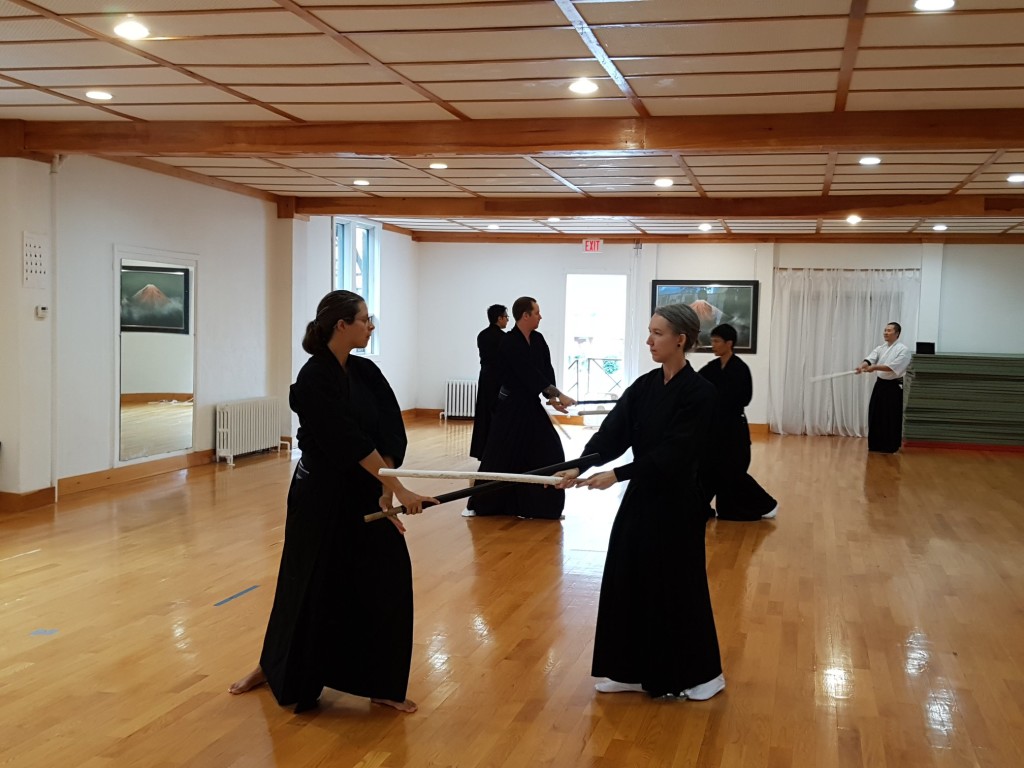 Your state of mind affects everything.
Your state of mind affects everything.
During our lunch break, we were introduced to some Katori Shintō Ryu Iaijutsu. This school of drawing the sword was created during war time and illustrate situations where your opponent may be wearing armour. Even your sitting posture is one in which you could be wearing armour yourself. The techniques are quite dynamic and full of energy, and embody the ‘Killing Sword’ mindset.
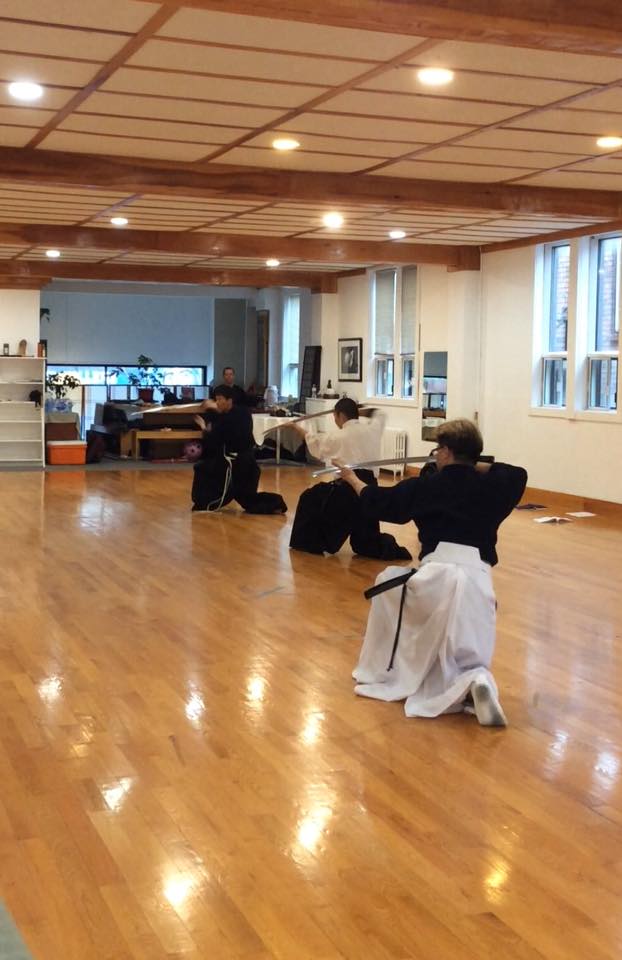 Tong Sensei demonstrating Katori Shinto Ryu iaijutsu, the art of drawing and cutting, an art both beautiful and deadly.
Tong Sensei demonstrating Katori Shinto Ryu iaijutsu, the art of drawing and cutting, an art both beautiful and deadly.
Because we were previously practicing YSR, it was important to have the ability to shift mindsets to properly be able to execute these kata. This in itself is not an easy feat, and understandably a reason why some people cannot practice both together. I found not only the movements to be foreign and challenging, but the mentality shift also.
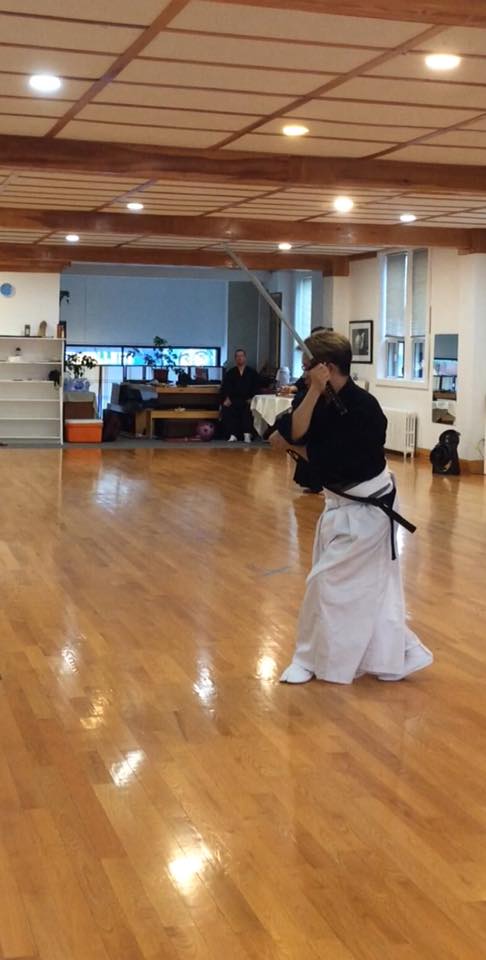 The Japanese sword is the spirit (tamashii – the soul) of the warrior (bushi).
The Japanese sword is the spirit (tamashii – the soul) of the warrior (bushi).
This mental shifting was an important theme throughout the day as Tong Sensei explained the concept of ‘ken-tai’: simultaneously attacking and waiting. By this, it means that if your body is in an attack stance, such as leaning or moving into your opponent’s range, then your mind is in a waiting stance and is calm and clear. And vice versa. It is crucial to not have both your body and mind in the same state or you create a vulnerability.
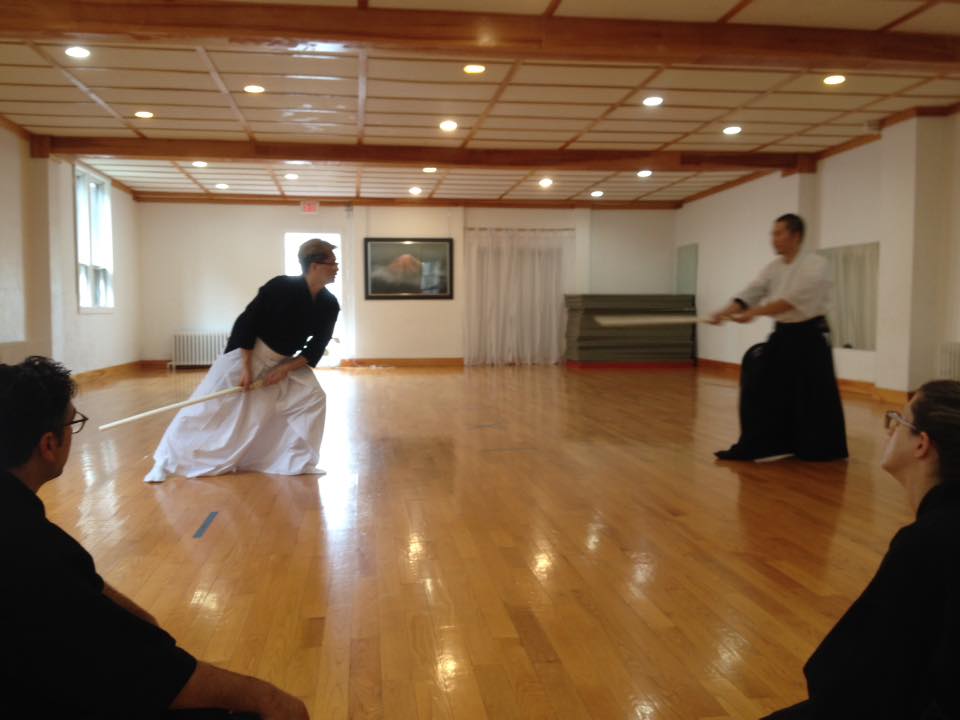 Tong Sensei demonstrating ken-tai: Here the body is in an attack stance (active) but the mind, unseen, is calm and waiting (passive).
Tong Sensei demonstrating ken-tai: Here the body is in an attack stance (active) but the mind, unseen, is calm and waiting (passive).
Earlier I mentioned how I observed our movements portray our mental state. I further learned that you can hold your body in a ready and attacking state without showing tension in your body, the key being that your mind not be in the same state. You can mentally be aware while maintaining calm, as you can also physically show calmness and appear non-threatening while your mind is fully alert. The object here is to be able to fluidly move between these states as any situation may need it without conflict. Yet another lesson from this serene school that can be practiced in our daily lives.
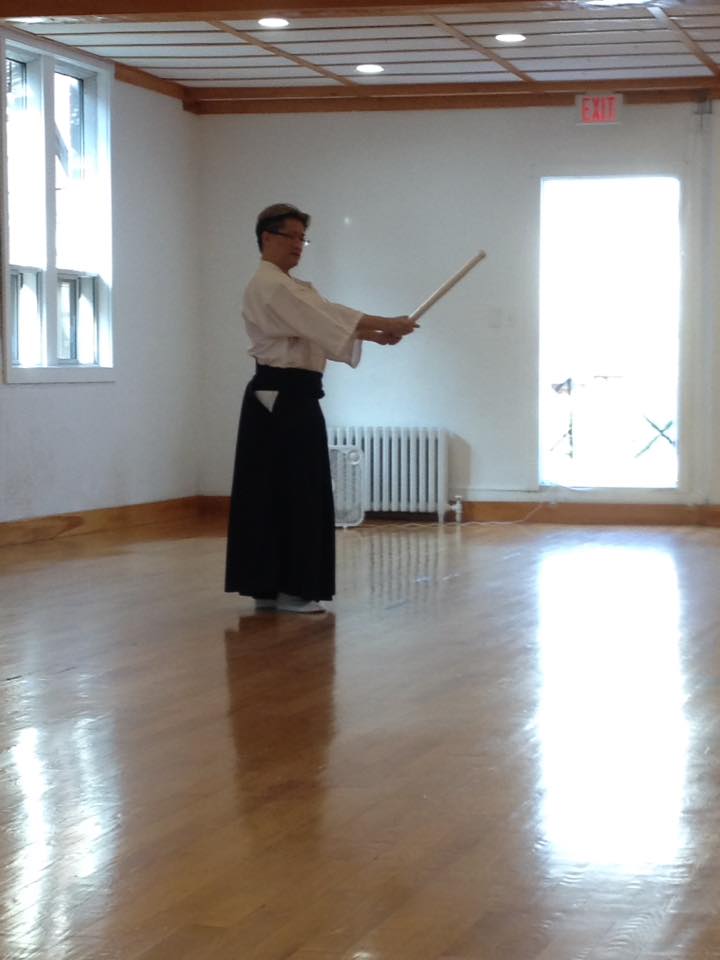 Another instance of ken-tai: “showing calmness and appearing non-threatening while the mind is fully alert”.
Another instance of ken-tai: “showing calmness and appearing non-threatening while the mind is fully alert”.
During our breaks throughout the day, we got some practice using only the Kodachi (short sword) and we all discovered a weakness that comes from only being familiar with one thing. Using a full length sword, or shinai or bokuto becomes limiting if it is the only weapon you use. Yes you learn how to efficiently use it, but you fail to learn its weaknesses and end up relying on your confidence in it. By using a shorter weapon and two swords at once, we were able to see how you can maneuver around a sword and take advantage of the opportunities that can create. Again I can’t help but see parallels to our own perceptions of what we know in life and the weaknesses we create by not having an open and empathic mind.
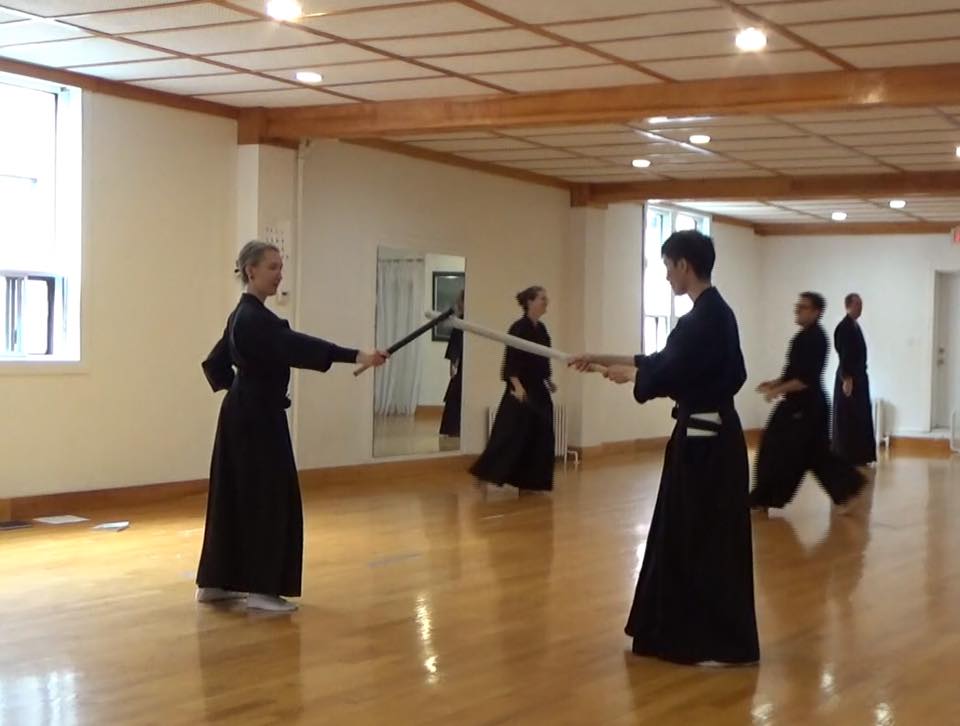 Short sword (kodachi) against a long sword: there are strengths and weaknesses to both weapons.
Short sword (kodachi) against a long sword: there are strengths and weaknesses to both weapons.
We wrapped up our seminar by having a circle discussion where we were able to ask any questions we may have collected over the weekend. I always appreciate these times where we sit casually and the air is open for earnest communication. In these moments, there is a mutual respect and consideration for what is being said and in turn no presence of ego or prejudice. It was a beautiful way to end what was a truly enlightening two days.
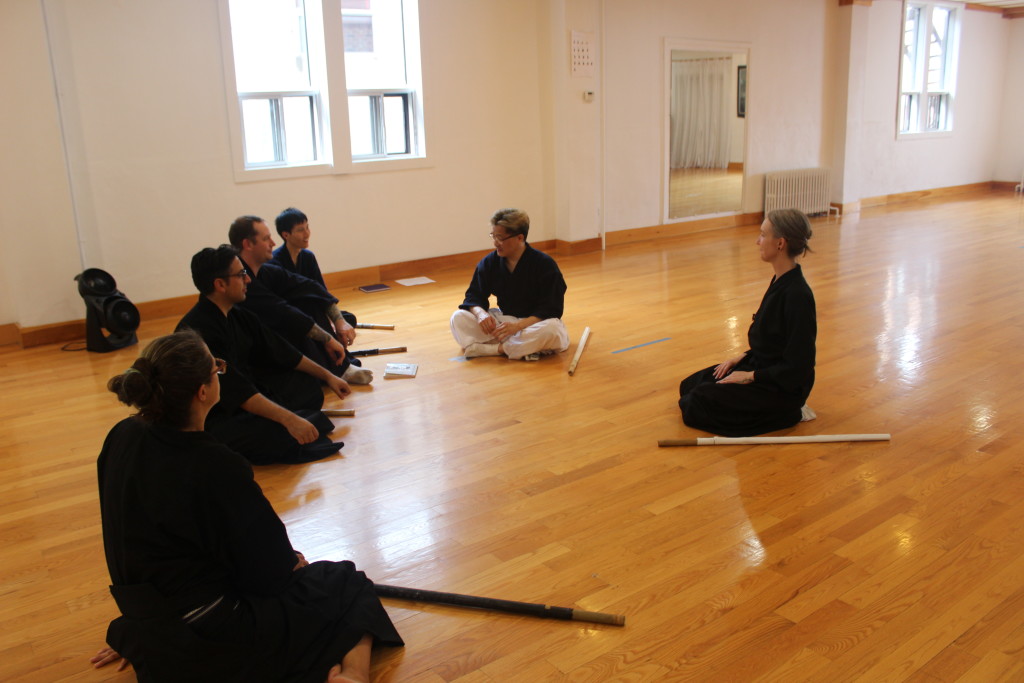 Post-seminar question-and-answer sessions are always enlightening!
Post-seminar question-and-answer sessions are always enlightening!
Before Sensei left us, we had a group leaders’ class where both Senseis Tong and Lo and I worked on spear and naginata techniques. As I’ve already mentioned, there are important lessons and insights that come from using various weapons of different size and it greatly improves your knowledge and understanding of the sword. When using a Kodachi or practicing Nito techniques, you challenge your comfort levels with danger and how close you actually have to be to it, whereas with longer weapons you have the extra reach to stay at a safe distance.
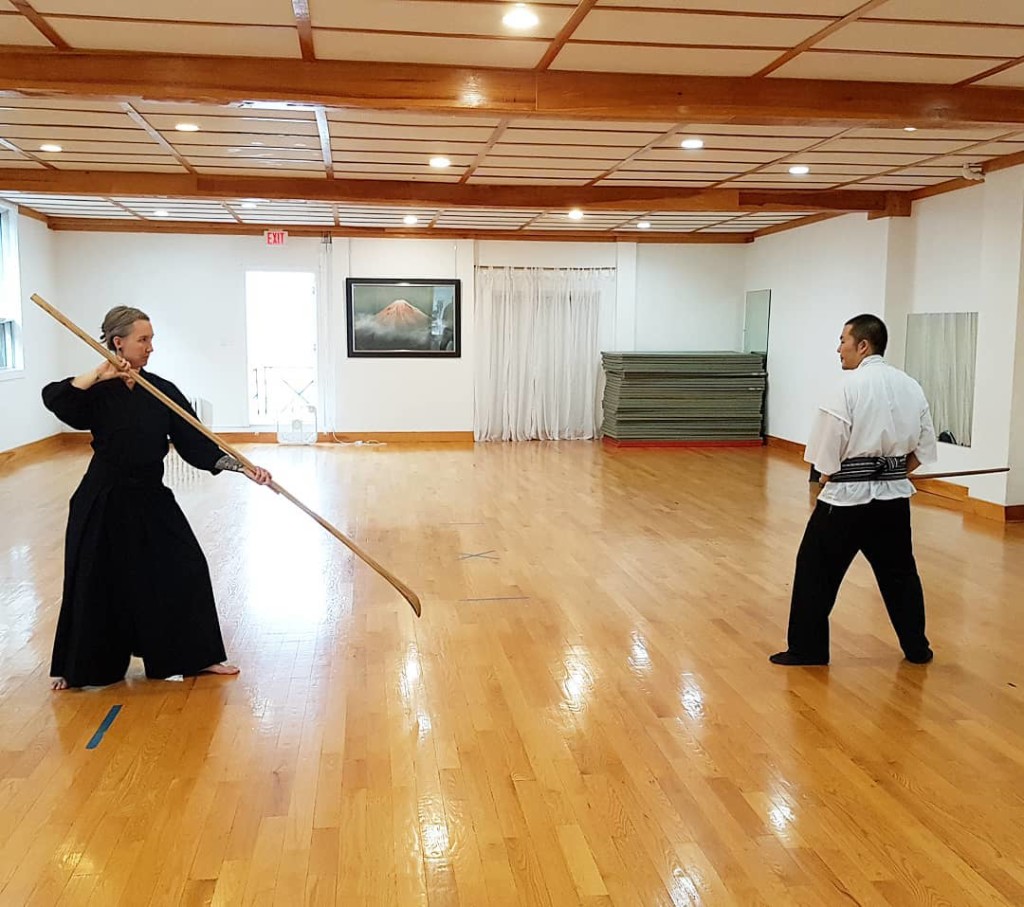 The naginata: a vicious battlefield weapon, used for reaping and mowing down opponents. Its advantage is its long range.
The naginata: a vicious battlefield weapon, used for reaping and mowing down opponents. Its advantage is its long range.
So the discomfort here comes with wielding the tool efficiently and quickly enough to be able to use it effectively. I am continually surprised with how awkward a new weapon can feel in comparison to something you’ve become familiar with, and find that to be an insight that relates to how we can feel in new situations day to day. The parallels between lessons in Budo and lessons in life are astounding- they really are no different. This only deepens the relevance of practicing the Seven Virtues of Bushido in our daily lives.
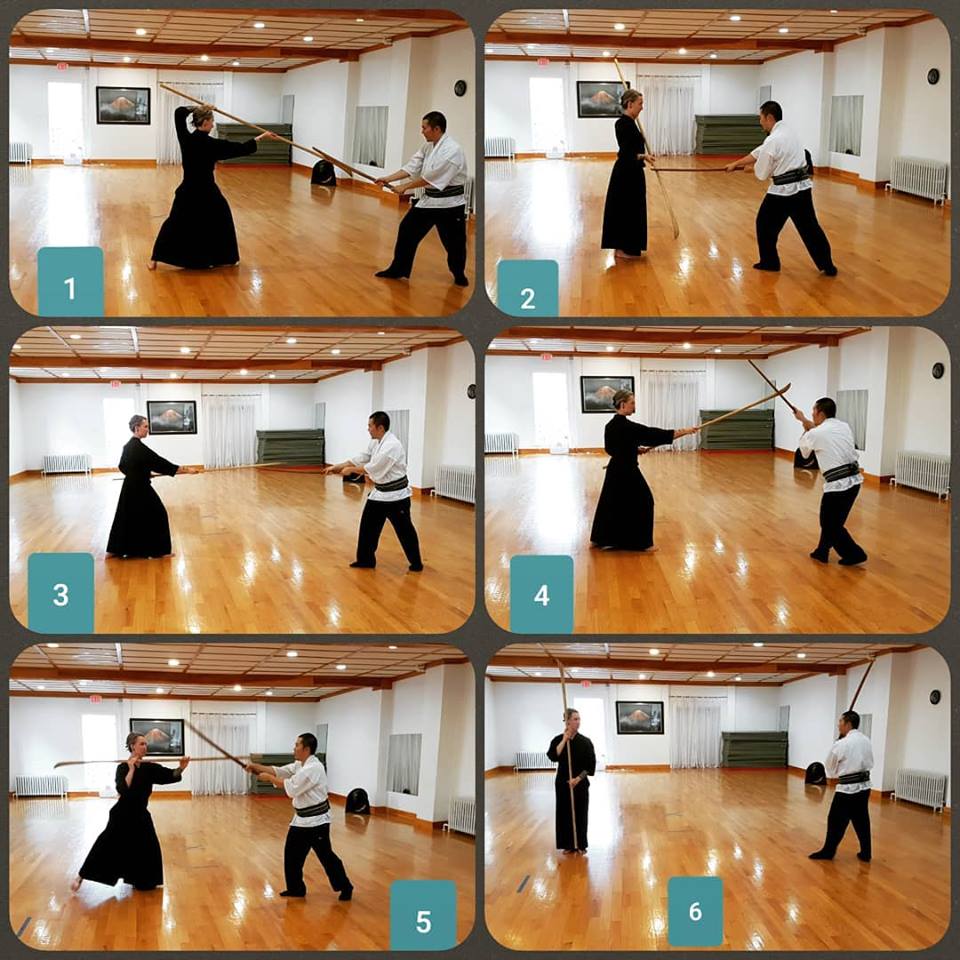 Being able to wield a naginata effectively takes a lot of practice because it is so ungainly.
Being able to wield a naginata effectively takes a lot of practice because it is so ungainly.
One of the things that continues to strike me in this community is how wonderfully joyful the training experience is. Although there is a seriousness and precision to what we are learning, there is also an emphasis to enjoy the learning process and to be grateful for the opportunity to do so. There is an understanding that without the lineage behind the art, and without Sensei or each other, we would not have the same potential for growth.
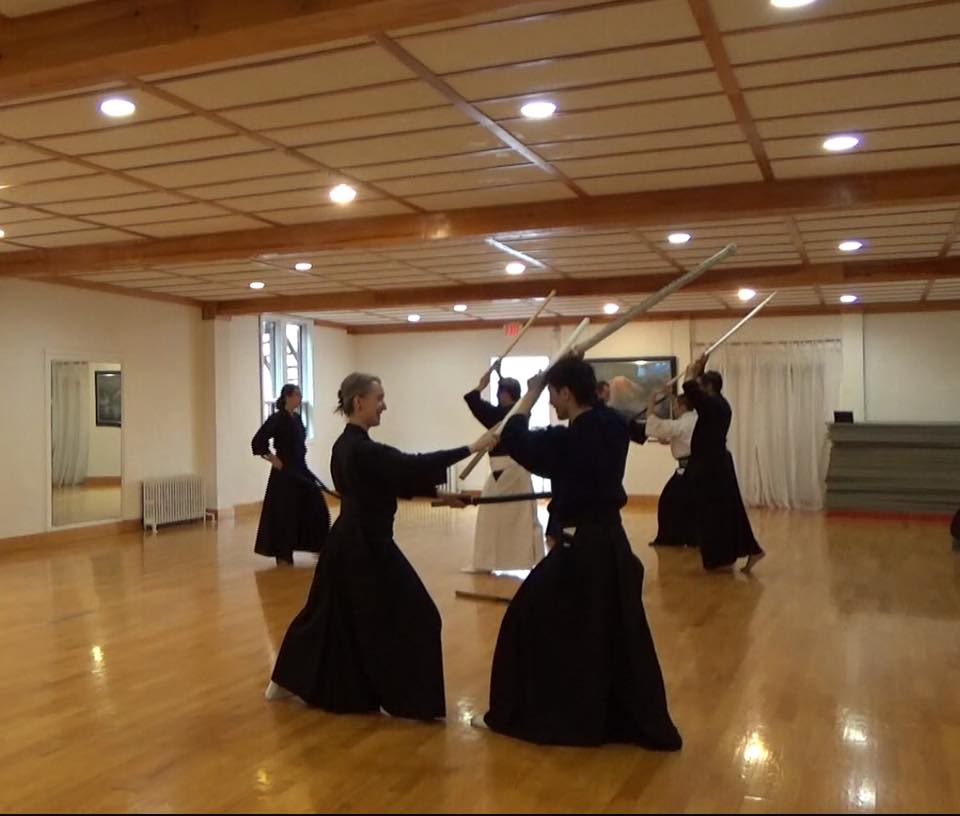 Training is a lot of fun!
Training is a lot of fun!
Every time I’ve had the pleasure to learn under Tong Sensei, it has left me with ample inspiration and motivation. His passion for teaching and passing on his knowledge in this school is uplifting and lives through his students, as is evident in Sensei Lo. Their demeanour and sincerity brings a smile to your face even while you are narrowly dodging a fukuro shinai!
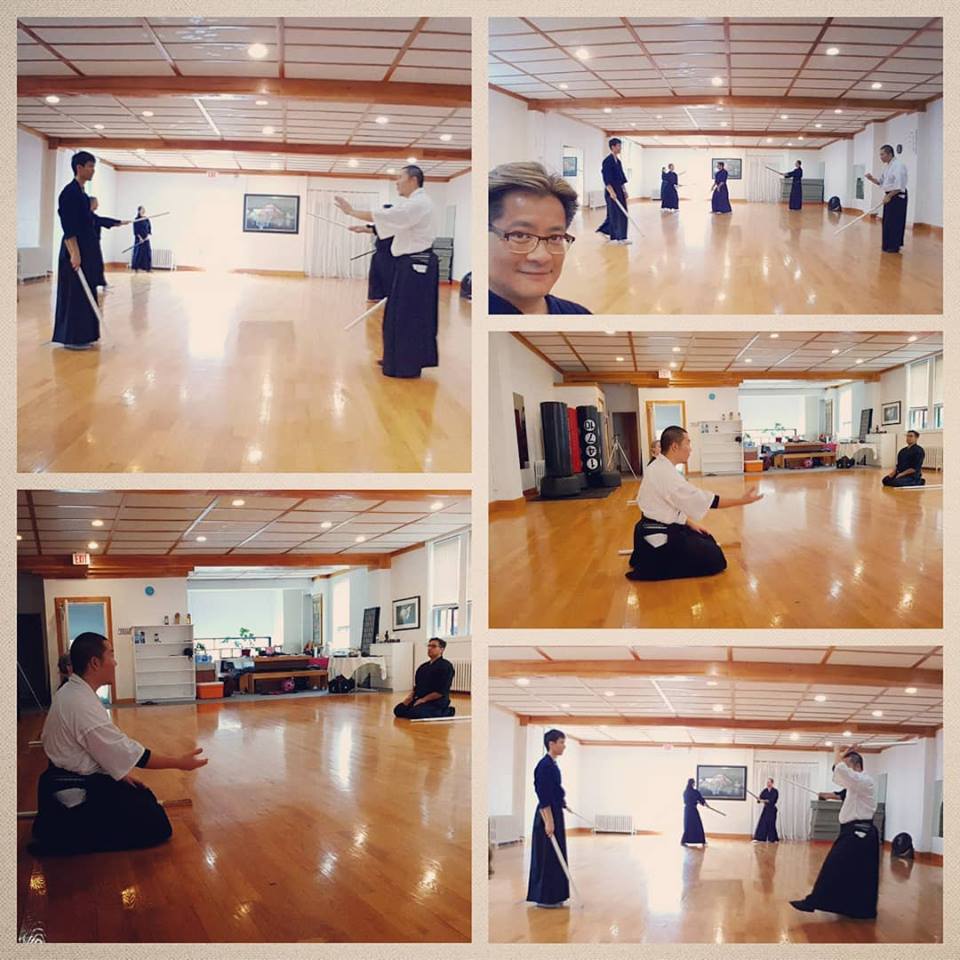 Derek Lo Sensei is the leader of the Montreal Group, runs his own dojo, and is one of Tong Sensei’s most experienced instructors.
Derek Lo Sensei is the leader of the Montreal Group, runs his own dojo, and is one of Tong Sensei’s most experienced instructors.
There is a deep gratitude that runs throughout Yagyu Shinkage Ryu, and I am truly blessed to be exposed to the serenity that can bring to one’s life.
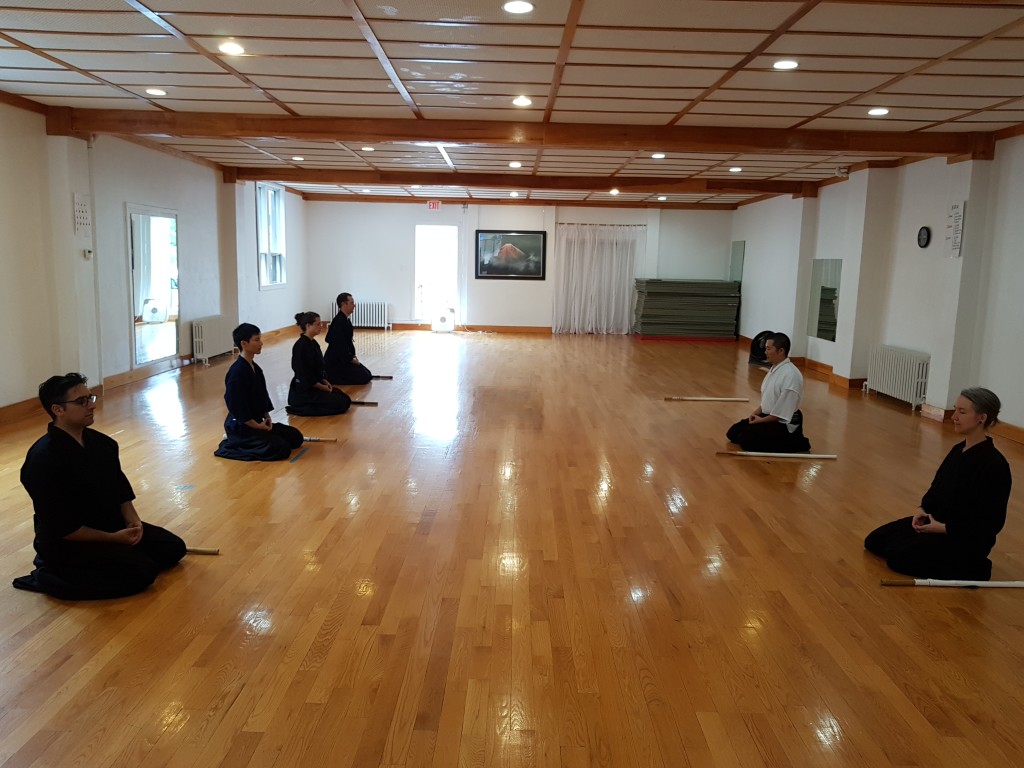 Yagyu Shinkage Ryu, with its core philosophy of the Life-Giving Sword, has deep ties to Zen Buddhism.
Yagyu Shinkage Ryu, with its core philosophy of the Life-Giving Sword, has deep ties to Zen Buddhism.
__________________________________________________
For more photos from this special event, visit Meishinkan’s Facebook page at: Meishinkan Kenjutsu on Facebook
__________________________________________________
San Gakuen, The Three Learnings – Reflections on the Labour Day seminar in Ottawa, 2018
copyright © 2018 Derek Lo, all rights reserved.
__________________________________________________
Life can get busy at times. It’s an unavoidable consequence of living in our society. When my life gets busy, I usually get caught up in all the complexities of my existence and I lose sight of the present moment. I value my time practicing martial arts as it helps me step away from my concerns, at least for a moment: nothing keeps you as focused on the present as a shinai speeding at your head!
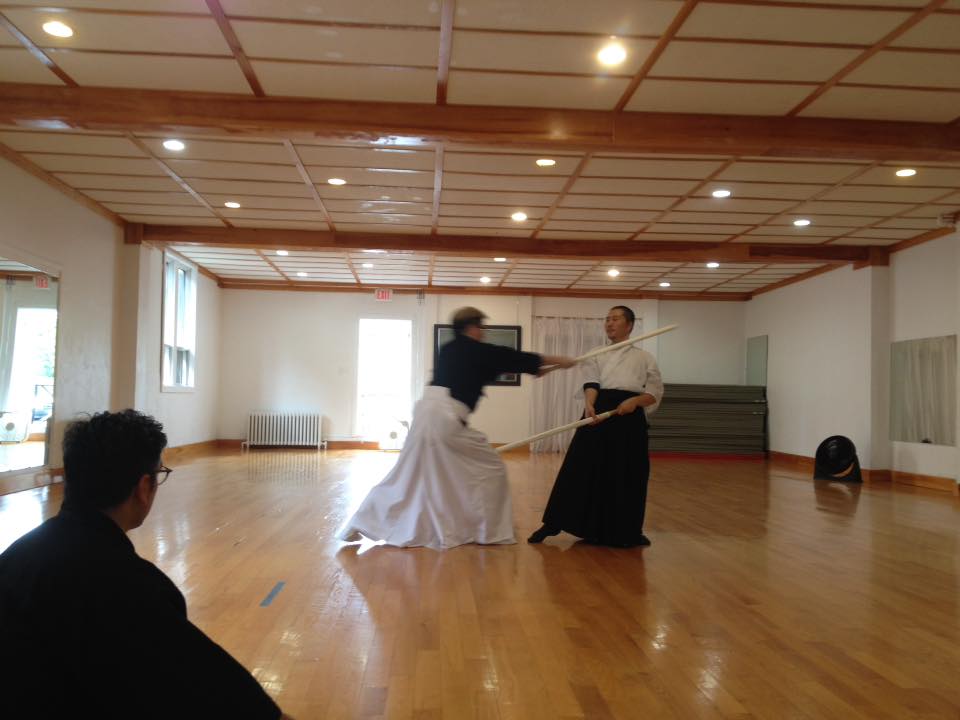 Lo Sensei is “present” in the moment of receiving an attack!
Lo Sensei is “present” in the moment of receiving an attack!
I didn’t always have this outlet though, and in the past I sought other ways to cope. In an effort to deal with the daily stresses of my life, I studied a bit of Buddhist philosophy at the temple my family belongs to. The beginner course focused on the first concepts of Buddhism known as the Three Learnings: Precepts (mindfulness), Meditation (awareness), and Wisdom (understanding). These three learnings are the foundation on a path to understanding life through Buddhist eyes. The most memorable lesson I learned through this course was that nothing was permanent and that everything has its time, and when that time is over it passes. Of course, this isn’t always the first thought in my head when my next mortgage payment is due, however seeing (at least in hindsight) that all the stress and worry I had for that one issue was no longer there afterward adds to the validity of the observation that everything is ephemeral. With this knowledge, I have tried to keep in mind that even though I feel I am in the middle of a chaos of thought and emotion, this moment will eventually pass. All I need to do is be mindful of myself as I process it all.
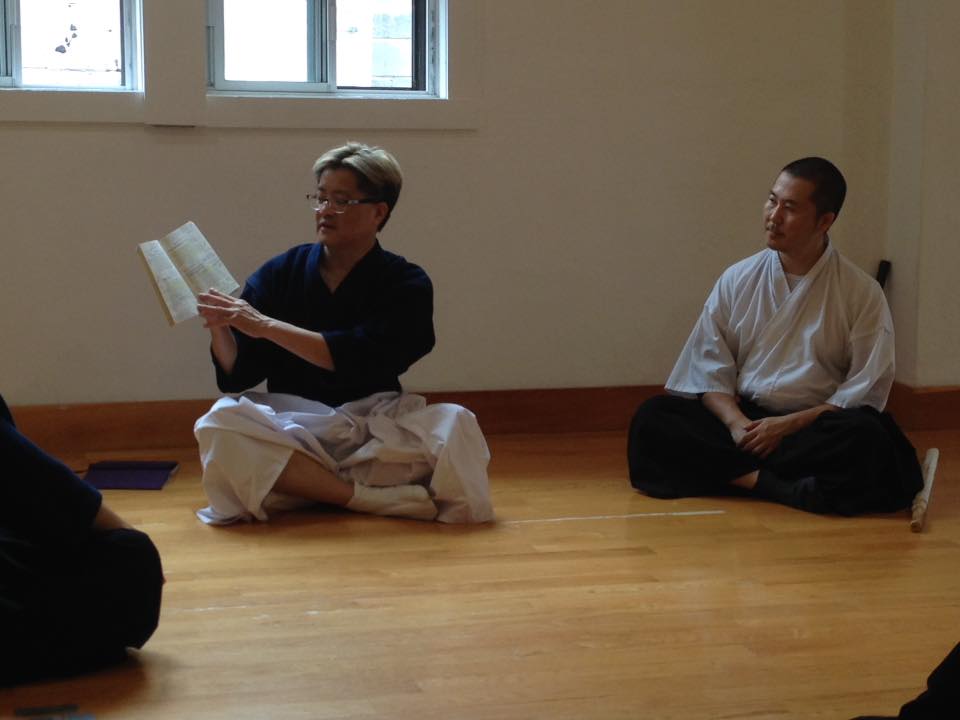 Mindfulness, awareness, and understanding: the Three Learnings of Buddhism.
Mindfulness, awareness, and understanding: the Three Learnings of Buddhism.
So how does this relate to martial arts? The lineage of Yagyu Shinkage Ryu (YSR) that I study has strong roots in the practice of Zen Buddhism. It is not surprising that the first kata set is also known as the Three Learnings (San Gakuen no Tachi). These foundational forms are what helps the practitioner in understanding kenjutsu through the eyes of YSR. During the September Labour Day long weekend, Sensei Tong held a seminar to examine the Three Learnings of YSR in Ottawa, Canada. Once again organized and hosted by the tireless efforts of Sensei Gaal at the Takahashi Dojo, the two-day training session was filled with an incredible amount of detail.
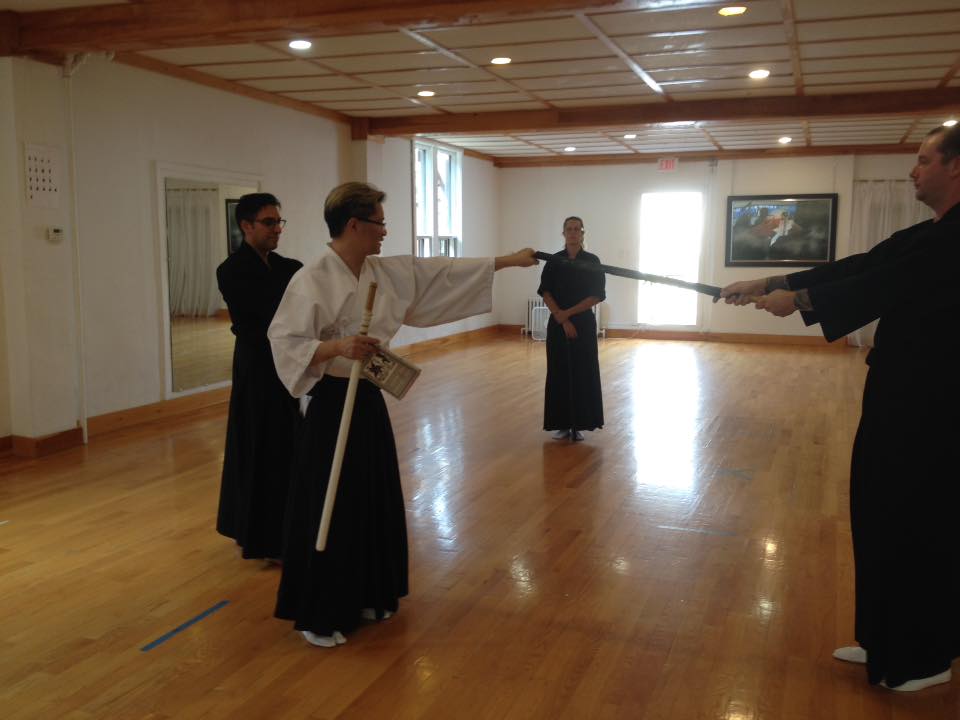 In this second seminar on Yagyu Shinkage Ryu, there was more focus on details.
In this second seminar on Yagyu Shinkage Ryu, there was more focus on details.
On Day One, Ottawa was in the middle of a heat wave and the dojo could be conservatively described as ‘a little hot’, however all the participants were eager to learn and practice. During the course of the afternoon and evening, we covered the five foundational katas that make up San Gakuen, focusing on the A Level movements (named Ue Kara in Japanese; movements broken down into discrete motions). These foundational methods help to build the students ability to defend themselves through proper body posture, sword control, and body motion. This required us to focus on being aware of where we were in space, and how we move through that space. During our training, we often stopped to gather in a discussion circle to speak about our impressions of the techniques we were learning. These moments of reflection allowed us to contemplate on what we were doing, and shape how we would continue as we once again returned to practice.
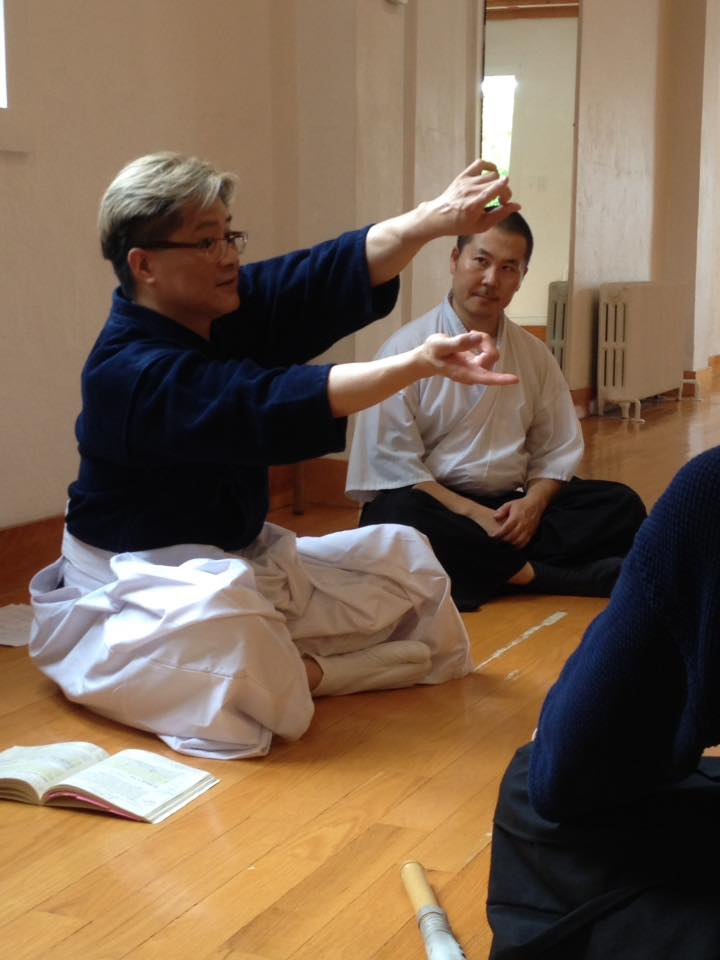 Gathering in our discussion circle to speak about our impressions of the techniques allows us to reflect on what we are and are not doing correctly.
Gathering in our discussion circle to speak about our impressions of the techniques allows us to reflect on what we are and are not doing correctly.
On Day Two, the rains started. However, there wasn’t much relief as the heat simply turned that rain into humidity. Undaunted, all the participants attended and trained with diligence in an environment that was ‘kind of like a sauna’. This time, we focused on the San Gakuen B Level (called Shita Kara), where the previous fragmented movements were smoothed out to encourage fluidity of motion. Furthermore, our reflections of the lessons from the previous day assisted us in beginning to be more mindful of ourselves, and aware of what was happening during the kata. As we moved through the difficulties of attack and defense, we began to become aware of the depth of what it is we were doing.
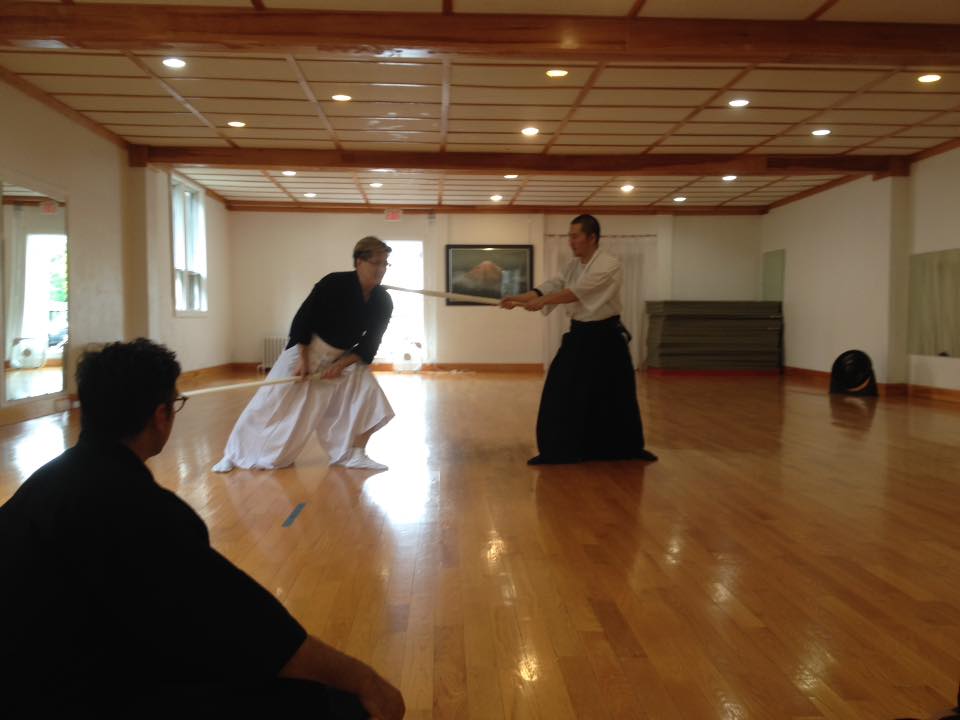 Discussing the complexities of attack and defense allows us to be aware of what is happening during the kata.
Discussing the complexities of attack and defense allows us to be aware of what is happening during the kata.
During those two days, I noticed that many of the practitioners found it difficult, even frustrating at times, to process and integrate all the information that was being given. As one of the senior practitioners, I tried assist others in understanding the concepts we were working on. I noticed how overwhelmed people began to get at times, and how often that feeling of being overwhelmed turned into self-criticism. I remember all the times I felt the same way, especially while practicing things with a high degree of complexity. During these moments, I experimented on trying to focus on the present with my partner and concentrating on one concept. With a bit of time, it seemed that the overwhelmed feeling began to pass and we began to once again open up to the multitude of concepts being practiced.
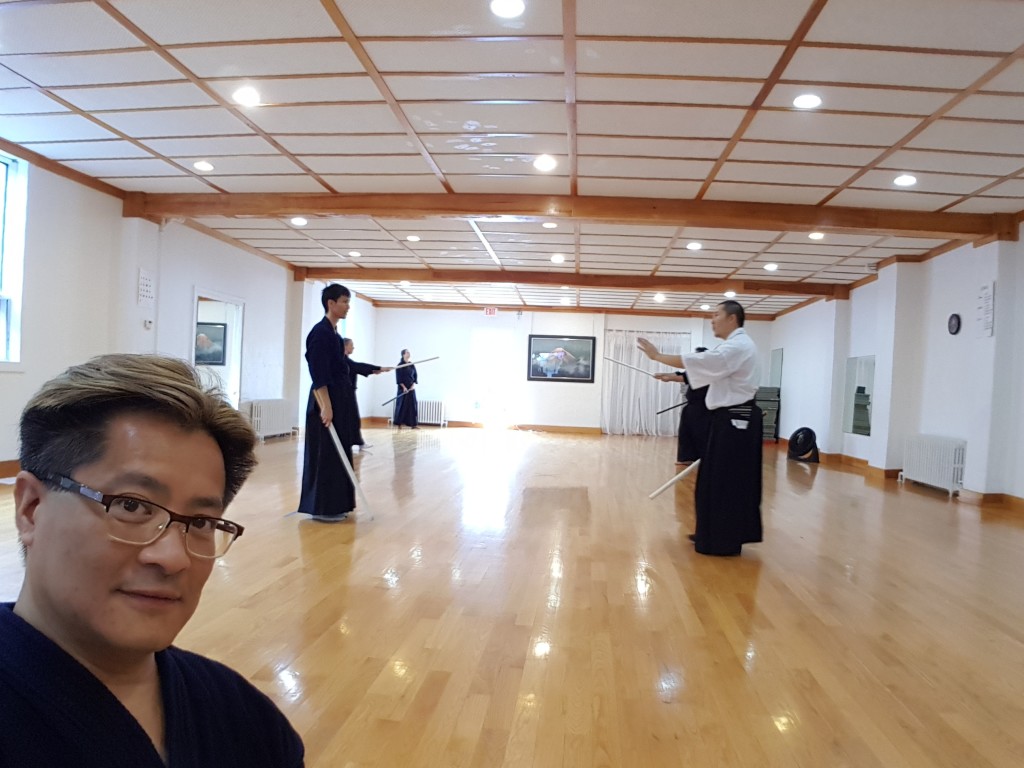 Lo Sensei helping a beginning student to understand the rationale behind the movements in the kata.
Lo Sensei helping a beginning student to understand the rationale behind the movements in the kata.
By the end of the second day, I noticed that all of the participants, myself included, had greatly improved on not only the body motions of the kata, but also the mental awareness needed when engaged in sword training. There was a sense of accomplishment and pride in us all for not only climbing a very steep mountain of knowledge, but also coming out the other side with a deeper understanding of our art and ourselves.
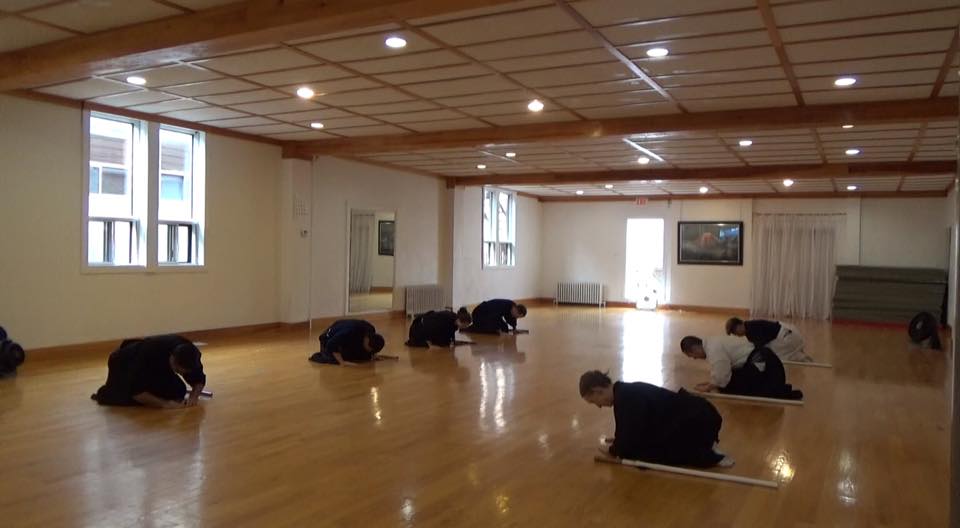 A deep sense of accomplishment and gratitude.
A deep sense of accomplishment and gratitude.
On the surface, the katas of San Gakuen focuses on learning the forms of YSR, however given the relationship with Zen Buddhism, I believe it has a much deeper meaning. From the San Gakuen of Buddhism one learns mindfulness, awareness, and understanding. In YSR, we practice mindfulness through training with care for our partners and our own safety. In addition, the philosophy of saving life, not ending it, is an intrinsic part of our lineage. We also practice meditation in the form of motion. Awareness of the current moment is critical for the safety of all around those around us. In this moving meditation, we practice staying present and aware of that moment.
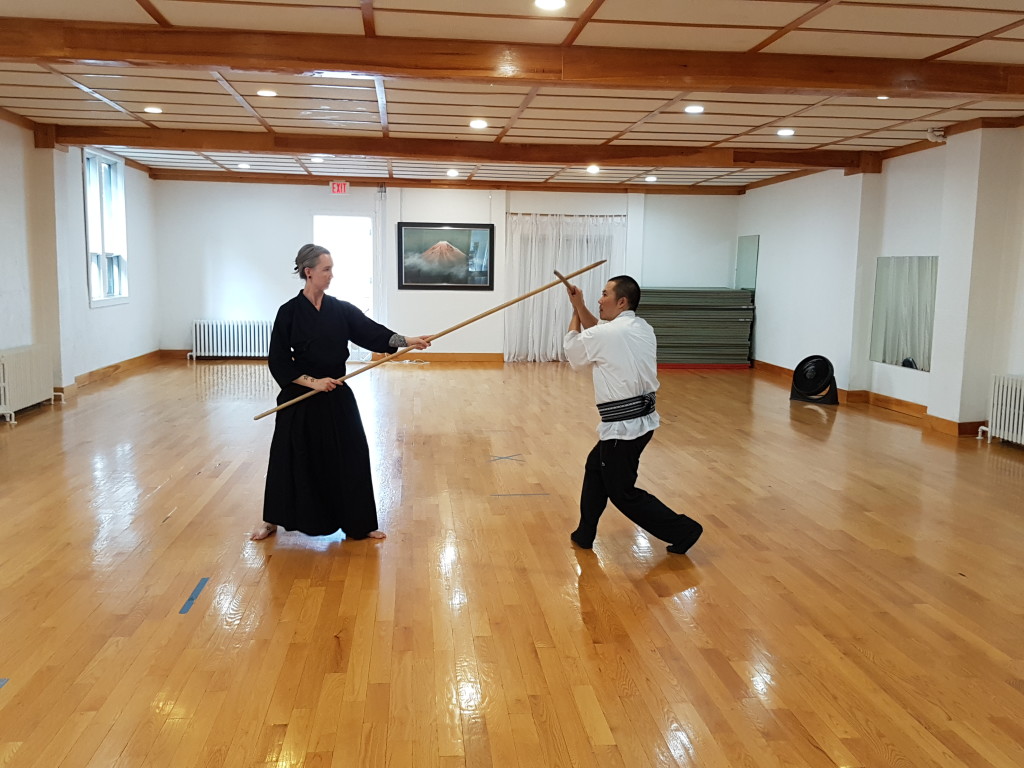 With a seven-foot blade coming at your face when you face a naginata, you learn to stay “present and aware” of the current moment. One miscalculation means that someone is going to the hospital.
With a seven-foot blade coming at your face when you face a naginata, you learn to stay “present and aware” of the current moment. One miscalculation means that someone is going to the hospital.
Finally, we work towards an understanding of YSR not only as an art but as a theory of life. If we see our world through YSR eyes, we can begin to understand conflict as something that need not be feared. Additionally, we become aware that in conflict there are many resolutions. We don’t have to WIN in order not to LOSE. Those kind of binary thoughts are illusions and often hindrances to our happiness and our lives. Bringing it one step further, maybe the idea of conflict itself is an illusion. Perhaps what we perceive as conflict can be seen as nothing but another ephemeral thought and emotion in our ever changing lives. In this way, our training in the San Gakuen of YSR can improve not only our kenjutsu, but also our outlook on life.
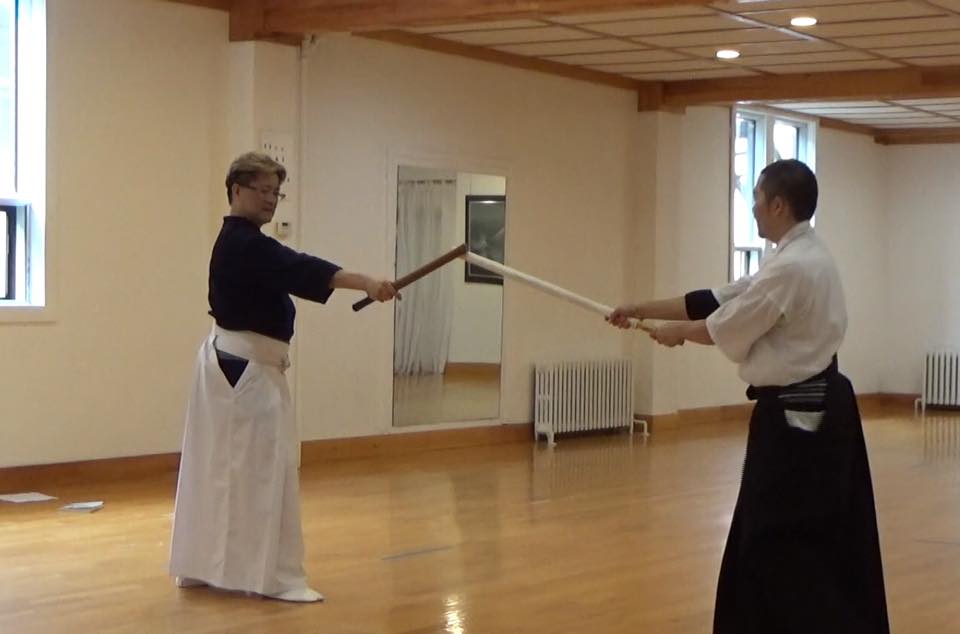 Facing an opponent armed only with your short sword, you must quickly learn to conquer your fear.
Facing an opponent armed only with your short sword, you must quickly learn to conquer your fear.
Thanks again to Sensei Tong for another great seminar, to Sensei Gaal for all her patience in organizing the event, and also all the attendees as everyone worked hard through less-than-ideal temperatures.
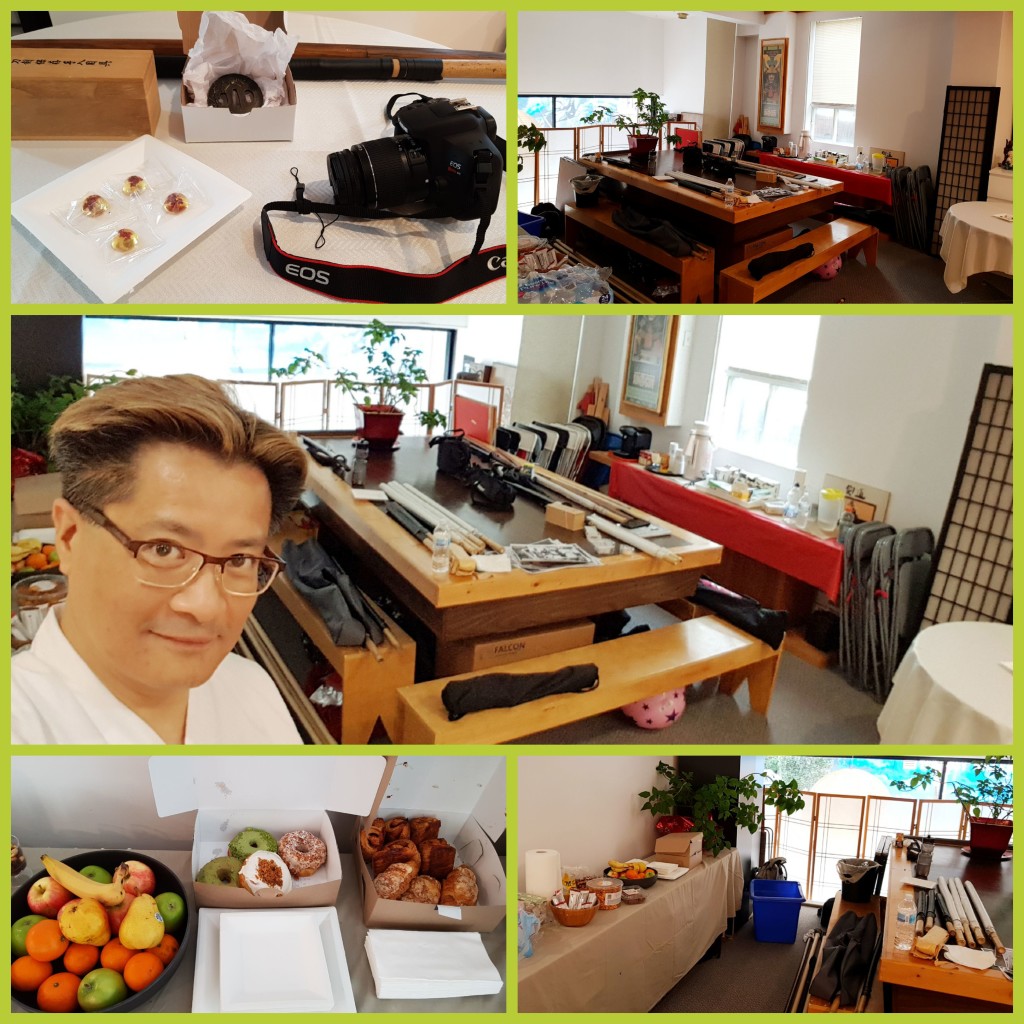 The busy rest area, full of refreshments, tools, and equipment of all sorts and sizes.
The busy rest area, full of refreshments, tools, and equipment of all sorts and sizes.
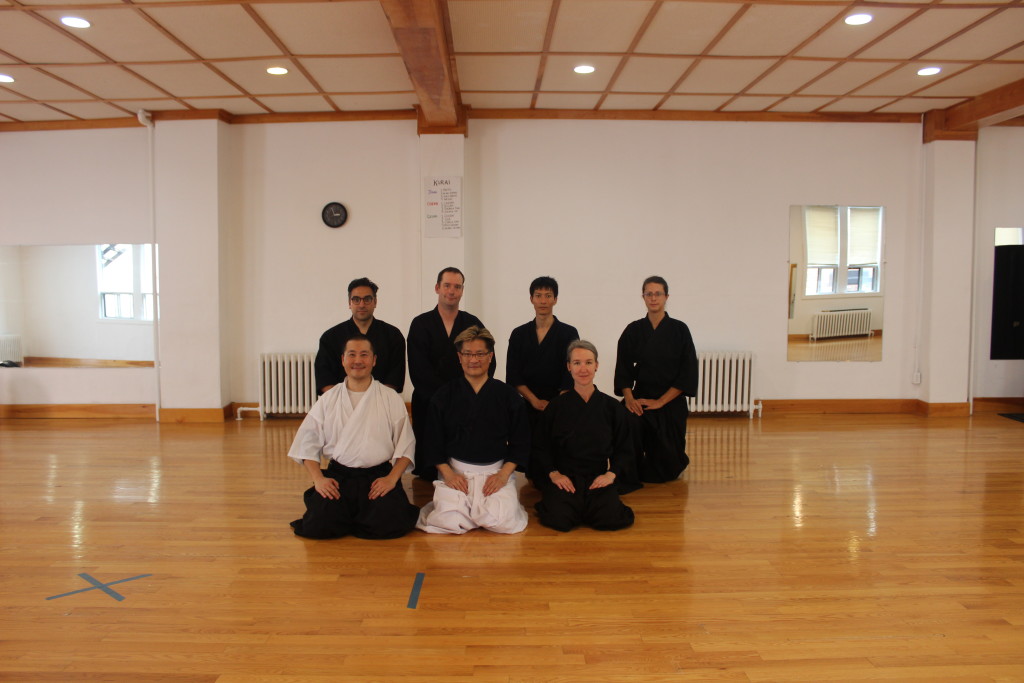 The Three Learnings 2018 Seminar Group. Thank you all for making it such a great experience!
The Three Learnings 2018 Seminar Group. Thank you all for making it such a great experience!
__________________________________________________
Read the original post on Oakville Kenjutsu’s website: San Gakuen, The Three Learnings – Reflections on the Labour Day seminar in Ottawa, 2018
__________________________________________________
